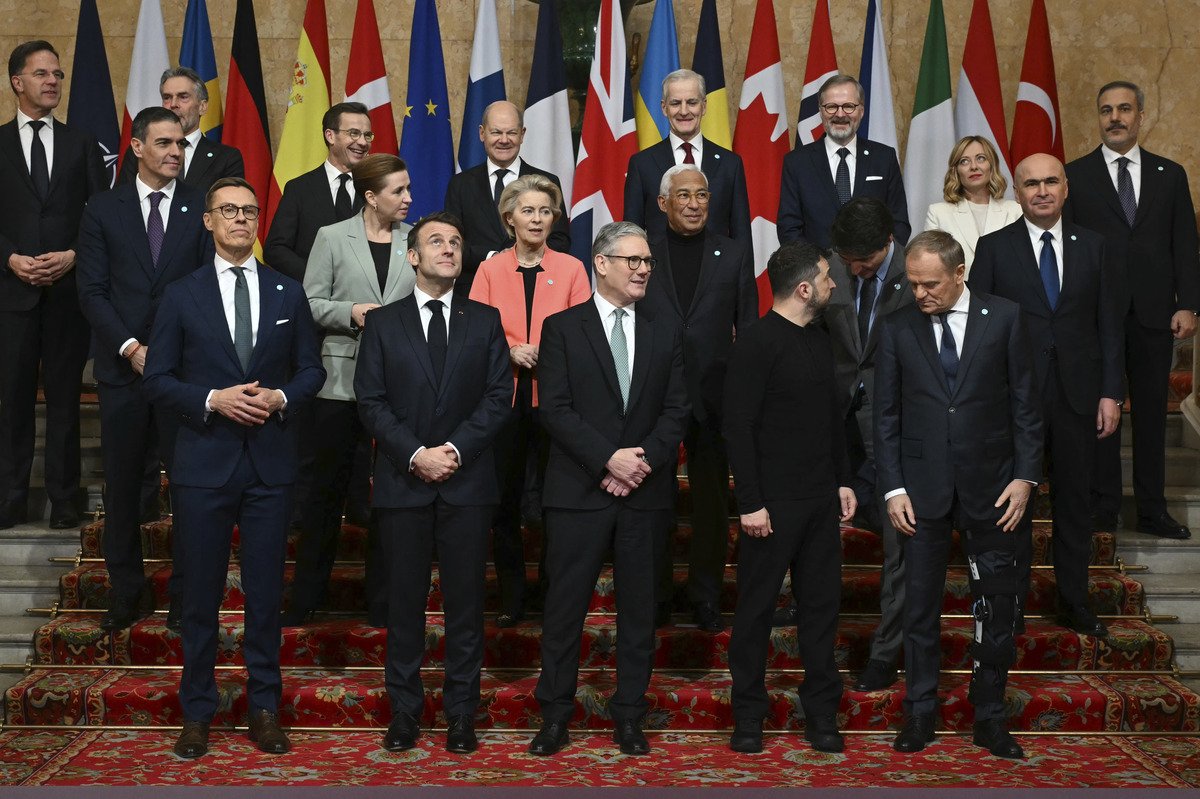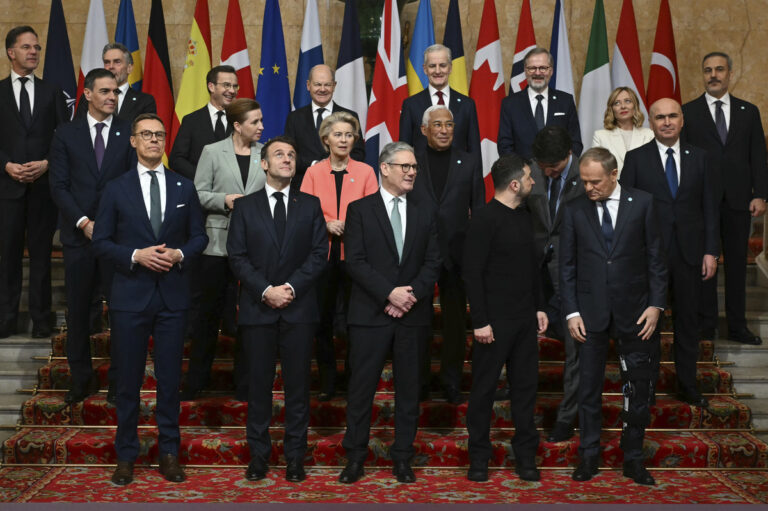Europe’s NATO members may publicly express confidence in the continent’s relationship with the U.S., but many European leaders are grappling with how to quickly bolster their defense capabilities to reset, but not scrap, longstanding ties with Washington.
The Financial Times reported on Thursday, citing unnamed officials, that Europe’s most significant military powers were putting together plans to take over much of the responsibility for protecting the continent from the U.S. This includes a proposal to the White House for Europe to take the reins within the next decade, according to the report.
Europe is contending with the reality of pledges to take responsibility for the continent’s defensive capabilities. Decades of sidelining defense spending after the end of the Cold War has allowed European countries to maintain prized social welfare systems, but has also left them with yawning capability gaps on defense and a deep reliance on the U.S. that has become increasingly unpalatable to the White House.
“This is a crisis,” one U.S. military official told Newsweek earlier this month.
“You are incredibly vulnerable,” they added, referring to the situation facing Europe. “Your European way of life is essentially dependent on Finland and Poland right now.”
Some European countries have stormed ahead. Baltic States within touching distance of Russian soil, as well as Poland, have pledged to exceed 3 percent of GDP on defense spending or more. Other countries, particularly those further the west in Europe like Italy and Spain, have not yet touched the 2-percent requirement outlined for NATO members.

Justin Tallis/Pool via AP
European defense spending surged by almost 12 percent in real terms in 2024, increasing for the 10th consecutive year, the International Institute for Strategic Studies (IISS), a U.K.-based think tank, said in February. Yet European military spending still accounts for less than a third of NATO’s total defense spending.
While consensus across Europe is difficult to achieve, several countries have made concerted efforts to haul up their own defense budgets. Denmark has said it will dedicate well above 3 percent of GDP on defense in 2025 and 2026 in response to the “urgency of the situation.”
“There is one message for the chief of defense: Buy, buy, buy,” Danish Prime Minister Mette Frederiksen said in February. “If we can’t get the best equipment, buy the next best. There’s only one thing that counts now and that is speed.”
The U.K., France, Germany and the Nordic countries are involved in talks to bring a pitch to the Oval Office for a phased handover of responsibility for defending Europe, the Financial Times reported, citing four European officials.
British Prime Minister Keir Starmer and French President Emmanuel Macron have been leading efforts to corral Europe, bringing as many countries into the fold of what has been termed a “coalition of the willing” to provide security guarantees under a possible ceasefire deal in Ukraine.
It would take between five and 10 years of elevated defense spending before Europe would have its own set of capabilities to replace those currently provided by the U.S., excluding American nuclear weapons, the FT reported.
“Increasing spending is the only play that we have: burden sharing and shifting the dial away from U.S. reliance,” one official told the newspaper. “We’re starting those talks but it’s such a big task that many are overwhelmed by the scale of it.”
Swelling Militaries
Dutch broadcaster NOS reported on March 21 that the Netherlands was hoping to more than double its army personnel numbers. The army would swell in size from 74,000 to roughly 200,000 personnel, including reservists and civilian roles, the broadcaster reported, citing anonymous sources.
Polish Prime Minister Donald Tusk said earlier this month that Warsaw hoped to funnel around 100,000 volunteers through military training each year from 2027. Tusk had said Poland needed a roughly 500,000-strong military, including reservists—a figure more than double the current numbers.
European Army and the EU
The nebulous idea of a European military has long floated around, but mostly dismissed as impractical and unnecessary while NATO exists in its current form.
But Ukrainian President Volodymyr Zelensky has pushed for a purely European military force in a rearranged world, speaking to continental leaders in Munich in February.
“I really believe that the time has come that the armed forces of Europe must be created,” Zelensky said. “Let’s be honest, now we can’t rule out that America might say ‘no’ to Europe on issues that might threaten it.”
European Commission President Ursula von der Leyen unveiled a new plan, dubbed “ReArm Europe,” earlier this month, saying up to $870 billion could be dedicated to defense in the European Union.
Baltic Defense Line
The three Baltic states of Latvia, Lithuania and Estonia signed an agreement back in January 2024 to beef up protection along their land borders with Russia and Belarus.
Belarus is a key Russian ally, and the Kremlin used Belarusian territory to help launch the full-scale invasion of Ukraine in February 2022. The country also links Russia with its isolated Kaliningrad exclave, sandwiched between NATO members Poland and Lithuania.
“We are undertaking this effort so that the people of Estonia can feel safe, but if the slightest risk emerged, we would be ready for various developments more promptly,” said Estonia’s defense minister, Hanno Pevkur. Tallinn said there would be a “network of bunkers, support points and distribution lines” along the border.
Lithuania said it had set up mines, and other defenses, like dragon’s teeth, against tanks and armored vehicles, close to the border with Kaliningrad.
Dragon’s teeth are concrete blocks used to halt tank advances and prevent mechanized infantry from gaining territory. This type of anti-tank fortification litters Ukraine.
Lithuania’s neighbor to the north, Latvia, has put similar defenses in place. The Latvian government has said around €303 million ($318 million) will be funneled into building up defenses on its eastern border with Russia over five years. There will be outposts for support personnel, reinforced structures, anti-tank trenches and storage dumps for ammunition and mines, Riga said.
“We will be able to slow down and block the movement of potential aggressors more efficiently,” Latvian Defense Minister Andris Sprūds said in a statement in last year.
Further to the south, staring down Kaliningrad and Belarus, Poland has started construction of what it has called its “East Shield,” costing over $2.5 billion and described by Warsaw as “the largest operation to strengthen Poland’s eastern border, NATO’s eastern flank, since 1945.”
Mass Evacuation Plans
The preparations aren’t just military, they’re civil, too. In mid-November, NATO’s newest member, Sweden, published a brochure it said helped the country’s residents to “learn how to prepare for, and act, in case of crisis or war.” The pamphlet outlines what a heightened state of alert would mean, how each inhabitant would pitch in to a war-time effort, and what different sirens sound like.
“Military threat levels are increasing,” the leaflet warns the Scandinavian country’s citizens. “We must be prepared for the worst-case scenario—an armed attack on Sweden.”
Norway, too, has published a leaflet on how to deal with “extreme weather, pandemics, accidents, sabotage—and in the worst case acts of war.”
Finland has publicly available guides on how it prepares for “the worst possible threat, war.”
Nuclear Weapons
Long-standing arrangements on nuclear weapons are being re-examined, too.
America’s formidable nuclear weapons arsenal, second only to Russia’s, has historically provided a powerful deterrent to any potential attack on a fellow NATO state.
Although the U.K. and France also have small stockpiles of nuclear weapons, there are big questions over the circumstances in which London and Paris would debate using these weapons and deep concerns over whether they are enough of a deterrent without America’s vast number of nukes.
British and French nuclear weapons amount to a fraction of Russia’s stockpile at under 300 warheads each.
France’s Macron has floated extending the protection of Paris’ nuclear weapons to the rest of Europe, a prospect welcomed by Poland and NATO’s Baltic States but slammed by the Kremlin as “extremely confrontational.”
Germany’s likely next chancellor, Friedrich Merz, said the “sharing of nuclear weapons is an issue we need to talk about,” but the rest of NATO should not lose America’s nuclear protection.
“The changed global security situation now necessitates that we Europeans discuss this matter together,” Merz added.


